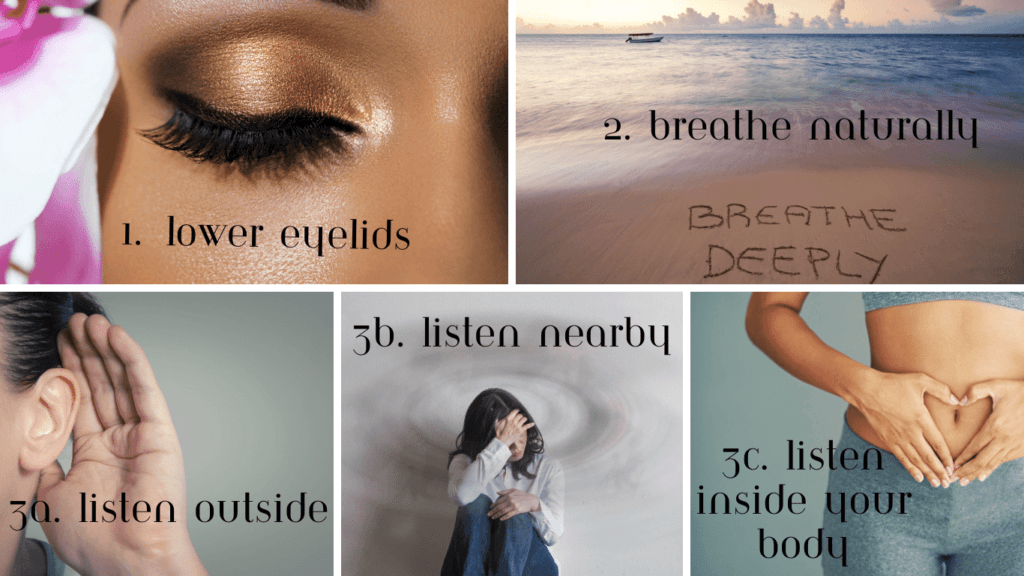
Please be sure to work through Step 1, taking time (about seven days) to really get the foundation in place. If not, the later steps may not work. Mindfulness is not a quick fix. You need to be patient and learn to enjoy quiet quality time with yourself.
What is self-awareness?
Self-awareness, in its essence, is the ability to observe oneself impartially without the biases and judgments that often cloud our perceptions.
It is about turning inward and becoming intimately acquainted with our thoughts, emotions, and beliefs. Imagine yourself as a curious explorer, venturing into uncharted territory within your mind, eager to unravel the mysteries beneath the surface.
How does it begin?
The journey of cultivating self-awareness begins with a simple yet powerful act: observation.
Take a moment to pause and tune into your inner landscape. Notice the thoughts that flit through your mind like passing clouds, the emotions that ebb and flow like the tide, and the beliefs that shape the lens through which you view the world.
Allow yourself to witness these phenomena with a gentle curiosity, resisting the urge to judge or analyze.
As you continue to observe, you may notice patterns emerging—recurring thoughts, entrenched emotions, and deeply held beliefs that have long remained hidden from view. These insights are like puzzle pieces, gradually coming together to form a clearer picture of who you are and what truly matters to you.
How deep does self-awareness go?
Self-awareness is not merely about understanding your surface-level preferences or personality traits; it delves deeper, penetrating the layers of conditioning and societal influences that have shaped your identity.
It is about peeling back the layers of the ego to reveal the essence of your being—the core values and authentic desires that serve as the guiding stars of your existence.
In pursuing self-awareness, it’s vital to approach yourself with kindness and compassion. Just as you would extend empathy to a friend navigating their journey of self-discovery, offer yourself the same level of understanding and support.
Remember that self-awareness is not about perfection or self-criticism; it’s about embracing the full spectrum of your humanity, with all its strengths and imperfections.
Why do I need to practice self-awareness?
Through the practice of self-awareness, you lay the essential groundwork for living a life that is aligned with your true nature. It should be a daily practice so you know how your mind works and learn to stand back from it to observe. This takes time. It’s not a quick fix.
Armed with a deeper understanding of yourself, you can make conscious choices that honour your values and aspirations rather than being swept along by the currents of external expectations.
Self-awareness is the cornerstone of living authentically—a beacon illuminating the path towards a life of purpose, fulfilment, and inner peace.
So, let’s embark on this journey with an open heart and a curious mind, knowing that the destination is not a fixed point but a continuous unfolding of self-discovery and growth.
There are several things to prepare before you can get started.
1. Setting up your Mindfulness Practice Place
It would be best to practise where you can be undisturbed by telephones or other people wanting your help or companionship. It will only work if you are alone with yourself. Make sure you can visit this place every day, too.
Choose somewhere comfortable where you can sit with your back straight without leaning. Make sure there is natural light if possible – a window is best. But an electric light will also work if you have no window. It is better to sacrifice a window than be disturbed.
It is also crucial that your mindful nook is well-ventilated. Make sure you can open a window or door and refresh the atmosphere.
2. Start a mindful journal or notebook.
Each mindfulness experience will likely inspire new thoughts and insights into your life. New feelings and thoughts will arise as you connect with your true nature or spirit. In your second-hand life, you perhaps rarely got the chance to be alone in this positive, motivated way.
So, please have a notebook and pen nearby so you can spend a few moments writing down your feelings after the practice. This kind of reflection is also mindful and will help to keep your place between your practices. If you are busy or life intervenes between practices, read your last reflection to revive your feelings and continue.
3. Timing and Frequency of Mindful Practices
Approximately 20 minutes is the ideal time to start, so it may help you set a timer or have a clock in view. As I mentioned earlier, trying to sit every day is essential. Eventually, you will look forward to this precious time alone with yourself. I also recommend you spend about one week on each of the five stages.
So, everything is ready. Let’s begin.
Mindful Practice 1: Foundation
You will start every mindful practice in this way. It is your foundation for creating self-awareness.
- Sitting as comfortably as you can without leaning back, sit up straight, imagining your spine (backbone) lengthening from the base to the crown of your head. It’s not about stretching but just imagining. Remember that your thoughts are so powerful that you can use positive ones to change your body.
- To help you concentrate, let your eyelids lower, but don’t close your eyes completely, as you may get drowsy. Awareness needs all of your attention. Almost close them, but leave a sliver of light exposed as you look down towards your lap.
- Now that your vision is quiet know what you can hear. Be careful not to judge or try to identify the sounds you hear by labelling them. Just regard them all as sounds. Sound is only energy. It moves where it will. Listen first to the sounds outside your practice place – outside the room or the house/building. Then, bring your attention inside and listen inside your practice place.
- As you listen and your vision is quiet, you will naturally breathe more deeply than usual. The correct way to breathe is: – IN through the nose and OUT through parted lips. Don’t try to extend your breath; observe it as you start to relax on each breath.
- Go back and check your spine – your breath and focused listening will help you lengthen your spine, so enjoy feeling this powerful series of bones which form the headquarters of your whole body.
- Notice how you feel as you divide your attention between listening, breathing and lengthening your spine in no particular order or duration.

By the time you have done all these things – above is a visual of the stages you can glance at if you forget – your 20 minutes will probably be up.
Don’t worry if you go on for over 20 minutes, either. That’s excellent if you are enjoying your mindful time.
Returning from your Journey Inside
As you return, gently let your eyelids rise and look around with your new, softened vision.
Notice how you feel, and after a few moments of readjustment, lean back or move to reflect on what happened during your practice and perhaps write something in your notebook – put the date and Mindful Practice Stage 1:1 at the top of your page. Tomorrow, you will write Mindful Practice Stage 1:2.
You may have nothing to write yet, but enjoy writing it down if you do.
Remember that this journal is only for you! You don’t have to let anyone else read it unless you want to.
That’s it. Your first mindful practice is complete. Congratulations!
Learning this foundation from memory will be helpful because you will undergo the same procedure daily. The visual above is good to jog your memory.
Stage 1 Affirmation: As you move through the rest of the day, let these words occur to you or say them repeatedly when you remember. Feel the emotion that comes with each keyword, such as Whole, Perfect, etc.
“I am Whole. I am Perfect. I am Strong. I am Powerful. I am Loving. I am Harmonised. I am Happy.”
Touch or click here to go on to Step 2: Clarify your Vision

